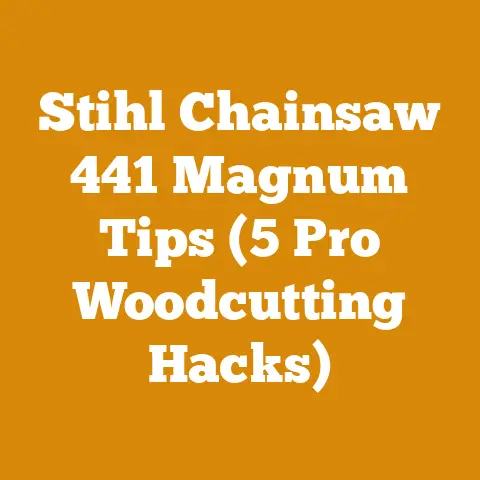What to Use to Kill a Tree Stump (Effective Arborist Methods)
A pristine, well-maintained yard significantly boosts curb appeal. A yard marred by unsightly tree stumps? Not so much. In fact, studies show that removing tree stumps can increase property value by as much as 3% to 7%. That’s a significant return on investment, especially when you consider the relatively low cost of stump removal compared to other home improvement projects.
That’s why understanding how to effectively kill a tree stump is crucial, not just for aesthetics, but for your bottom line. And while there are many methods out there, I’m going to focus on those preferred by arborists – professionals who know a thing or two about trees and their stubborn remains.
Key Takeaways:
- Property Value Boost: Removing tree stumps can increase your property value by 3-7%.
- Arborist-Approved Methods: We’ll focus on techniques professionals use for effective stump removal.
- Safety First: Always prioritize safety when handling chemicals or operating machinery.
- Long-Term Solutions: The goal is complete stump eradication, preventing regrowth and future problems.
- DIY vs. Professional: Knowing when to tackle it yourself and when to call in the experts is key.
Why Kill a Tree Stump?
Beyond the obvious aesthetic improvements, there are several compelling reasons to get rid of those unwanted stumps.
- Safety Hazard: Stumps can be tripping hazards, especially for children and the elderly.
- Pest Attraction: Decaying wood attracts insects like termites, ants, and beetles, which can then infest your home.
- Regrowth Potential: Some trees stubbornly send up new shoots from the stump, requiring constant pruning.
- Lawn Care Obstacle: Mowing around stumps is a pain, and they can damage your lawnmower.
- Aesthetic Eyesore: Let’s face it, they just don’t look good.
Understanding Tree Stump Biology: Why Killing is Necessary
A tree stump isn’t just a dead piece of wood. It’s a biological structure that, depending on the species, can remain viable for years. The root system continues to draw nutrients and moisture from the soil, allowing the stump to sprout new growth. This is particularly true for species like aspen, willow, and even some fruit trees.
Data Point: Studies have shown that certain tree species can survive as stumps for over 20 years, continuously sending up shoots if left untreated.
Killing the stump effectively stops this process by disrupting the root system’s ability to sustain life. This prevents regrowth and accelerates decomposition, ultimately leading to the stump’s complete removal.
Effective Arborist Methods for Killing Tree Stumps
Now, let’s dive into the methods that arborists rely on to eliminate tree stumps effectively. I’ll break down each technique, including its pros, cons, and step-by-step instructions.
1. The Chemical Method: Potassium Nitrate Stump Removal
This is one of the most common and effective methods used by professionals, especially for larger stumps. Potassium nitrate, also known as saltpeter, is a powerful oxidizing agent that accelerates the decomposition of wood.
How it Works: Potassium nitrate creates an environment conducive to fungal growth. The fungi then break down the lignin and cellulose in the wood, weakening the stump and making it easier to remove.
My Personal Experience: I’ve used potassium nitrate on several occasions, particularly for large oak stumps. The key is patience. It’s not an overnight solution, but it’s incredibly effective in the long run.
Step-by-Step Instructions:
-
Gather Your Materials:
- Potassium nitrate stump remover (available at garden centers or online)
- Drill with a large drill bit (1/2 inch to 1 inch)
- Water
- Plastic tarp or heavy-duty garbage bag
- Gloves and eye protection
-
Drill Holes: Using the drill, create a series of holes in the stump. Drill as deep as possible, spacing the holes about 4-6 inches apart. Focus on drilling into the cambium layer (the layer just under the bark) as this is where the active growth cells are located. Also drill angled holes into the sides of the stump.
-
Mix the Solution: Follow the instructions on the potassium nitrate product to mix the solution. Typically, you’ll dissolve the crystals in warm water.
-
Pour the Solution: Carefully pour the solution into the drilled holes, filling them completely.
-
Saturate the Stump: Pour any remaining solution over the entire surface of the stump, ensuring it is thoroughly saturated.
-
Cover the Stump: Cover the stump with a plastic tarp or heavy-duty garbage bag to retain moisture and prevent the solution from being washed away by rain. Secure the tarp with rocks or bricks.
-
Wait and Monitor: This process takes time. Depending on the size of the stump and the weather conditions, it can take several weeks to several months for the stump to decompose significantly. Check the stump periodically to ensure it remains moist. If necessary, reapply the solution.
-
Chop and Remove: Once the stump has become soft and spongy, you can start chopping it apart with an axe or mattock. The decomposed wood will be much easier to remove than solid wood.
-
Fill the Hole: After removing the stump, fill the hole with soil and replant grass or other vegetation.
Pros:
- Effective for large stumps
- Relatively easy to apply
- Accelerates decomposition
Cons:
- Takes time (weeks to months)
- Requires careful handling of chemicals
- May not be suitable for environmentally sensitive areas
Safety Precautions:
- Always wear gloves and eye protection when handling potassium nitrate.
- Keep the product out of reach of children and pets.
- Avoid contact with skin and eyes. If contact occurs, rinse thoroughly with water.
- Do not inhale the dust or fumes.
- Store the product in a cool, dry place away from flammable materials.
2. The Epsom Salt Method: A Natural Approach
Epsom salt (magnesium sulfate) is another method often touted as a more natural alternative to potassium nitrate. While it’s not as potent, it can still be effective in drying out the stump and accelerating decomposition.
How it Works: Epsom salt draws moisture out of the wood, creating a hostile environment for the tree’s remaining cells. This dehydration weakens the stump and makes it more susceptible to fungal decay.
My Personal Experience: I’ve used Epsom salt on smaller stumps, particularly in areas where I was concerned about the potential impact of chemicals on the surrounding soil. It’s a gentler approach, but it still requires patience.
Step-by-Step Instructions:
-
Gather Your Materials:
- Epsom salt
- Drill with a large drill bit (1/2 inch to 1 inch)
- Water
- Bucket
- Gloves
-
Drill Holes: Drill holes in the stump as described in the potassium nitrate method.
-
Mix the Solution: Dissolve Epsom salt in warm water to create a concentrated solution. The more salt you dissolve, the better.
-
Pour the Solution: Pour the Epsom salt solution into the drilled holes, filling them completely.
-
Saturate the Stump: Pour any remaining solution over the entire surface of the stump.
-
Repeat Application: Reapply the Epsom salt solution every few weeks, especially after rain.
-
Wait and Monitor: As with potassium nitrate, this process takes time. Monitor the stump for signs of decomposition.
-
Chop and Remove: Once the stump has become soft and spongy, chop it apart and remove it.
-
Fill the Hole: Fill the hole with soil and replant grass or other vegetation.
Pros:
- More natural alternative to chemical stump removers
- Relatively easy to apply
Cons:
- Less effective than potassium nitrate
- Takes longer to work
- May require multiple applications
Safety Precautions:
- While Epsom salt is generally safe, avoid ingestion.
- Wear gloves to prevent skin irritation.
3. The “Wait and Rot” Method: Natural Decomposition
This is the most hands-off approach, but also the slowest. It relies on natural decomposition processes to break down the stump over time.
How it Works: Fungi, insects, and other organisms naturally break down wood. By creating an environment conducive to these organisms, you can accelerate the decomposition process.
My Personal Experience: I’ve used this method in heavily wooded areas where aesthetics weren’t a primary concern. It’s a slow burn, but it requires minimal effort.
Step-by-Step Instructions:
-
Prepare the Stump: Cut the stump as close to the ground as possible.
-
Create a Favorable Environment: Cover the stump with a layer of soil, compost, or wood chips. This will help retain moisture and attract beneficial organisms.
-
Keep it Moist: Water the stump regularly to keep it moist.
-
Fertilize (Optional): Applying a nitrogen-rich fertilizer can help accelerate decomposition by providing nutrients for the organisms breaking down the wood.
-
Wait and Monitor: This process can take several years, depending on the size of the stump and the climate.
-
Chop and Remove (Eventually): Eventually, the stump will become soft and crumbly, making it easier to chop apart and remove.
Pros:
- Minimal effort
- No chemicals involved
Cons:
- Extremely slow
- Not suitable for areas where aesthetics are important
- May attract pests
4. The Grinding Method: Mechanical Stump Removal
Stump grinding involves using a specialized machine called a stump grinder to mechanically grind the stump into small chips. This is a fast and effective method, but it requires specialized equipment or hiring a professional.
How it Works: A stump grinder has a rotating cutting wheel with carbide teeth that grind the wood into small pieces. The chips can then be used as mulch or removed from the site.
My Personal Experience: I’ve rented stump grinders for larger projects and have also hired professionals. It’s a powerful method, but it can be dangerous if not handled properly.
Step-by-Step Instructions (If Renting):
-
Rent a Stump Grinder: Contact a local rental company to rent a stump grinder. Be sure to get instructions on how to operate the machine safely.
-
Clear the Area: Remove any rocks, debris, or other obstacles from around the stump.
-
Safety Gear: Wear safety glasses, hearing protection, and heavy gloves.
-
Position the Grinder: Position the stump grinder so that the cutting wheel is directly over the stump.
-
Start Grinding: Slowly lower the cutting wheel into the stump and begin grinding. Move the grinder back and forth across the stump, grinding it down to below ground level.
-
Grind the Roots (Optional): If desired, you can also grind the larger roots extending from the stump.
-
Remove the Chips: Rake up the wood chips and dispose of them or use them as mulch.
-
Fill the Hole: Fill the hole with soil and replant grass or other vegetation.
Pros:
- Fast and effective
- Removes the stump completely
Cons:
- Requires specialized equipment or hiring a professional
- Can be expensive
- Can be dangerous if not handled properly
Safety Precautions:
- Always wear safety glasses, hearing protection, and heavy gloves when operating a stump grinder.
- Keep bystanders away from the machine.
- Be aware of underground utilities.
- Follow the manufacturer’s instructions carefully.
5. The Burning Method: A Controlled Burn (Check Local Regulations!)
Burning a tree stump is a quick and effective way to remove it, but it is essential to check local regulations and obtain any necessary permits before attempting this method. Many areas have strict rules regarding open burning due to fire hazards and air quality concerns.
How it Works: Burning completely incinerates the stump, leaving behind only ash. It’s a fast method but requires careful control and consideration of environmental factors.
My Personal Experience: I’ve only used this method in very rural areas where burning was permitted and safe. It’s a powerful method, but the risks are significant.
Step-by-Step Instructions (If Permitted and Safe):
-
Obtain Permits: Check with your local fire department or environmental agency to determine if burning is permitted in your area and obtain any necessary permits.
-
Clear the Area: Clear a wide area around the stump of any flammable materials, such as dry grass, leaves, or brush.
-
Dig a Pit: Dig a pit around the stump to contain the fire.
-
Drill Holes: Drill holes in the stump as described in the potassium nitrate method.
-
Soak with Kerosene (Optional): Soaking the stump with kerosene or another flammable liquid can help it burn more readily. Use extreme caution when handling flammable liquids.
-
Start the Fire: Start a fire in the pit around the stump.
-
Monitor the Fire: Monitor the fire constantly and keep it under control. Have a water source nearby to extinguish the fire if necessary.
-
Let it Burn: Allow the fire to burn until the stump is completely consumed.
-
Extinguish the Embers: Once the stump has burned down, extinguish any remaining embers with water.
-
Fill the Hole: Fill the hole with soil and replant grass or other vegetation.
Pros:
- Fast and effective
Cons:
- Requires permits and adherence to local regulations
- Significant fire hazard
- Air pollution
Safety Precautions:
- Never attempt to burn a stump without first checking local regulations and obtaining any necessary permits.
- Clear a wide area around the stump of any flammable materials.
- Have a water source nearby to extinguish the fire if necessary.
- Monitor the fire constantly and keep it under control.
- Never leave a fire unattended.
Choosing the Right Method: Factors to Consider
The best method for killing a tree stump depends on several factors:
- Size of the Stump: Larger stumps may require more aggressive methods like potassium nitrate or stump grinding.
- Species of Tree: Some tree species are more resistant to decomposition than others.
- Location of the Stump: Stumps near buildings or underground utilities may require more careful methods.
- Environmental Concerns: If you are concerned about the impact of chemicals on the environment, consider using Epsom salt or the “wait and rot” method.
- Budget: Stump grinding can be expensive, while other methods are more affordable.
- Time: Some methods take weeks or months, while others are much faster.
- Local Regulations: Always check local regulations before burning a stump.
When to Call a Professional
While many of these methods can be done DIY, there are times when it’s best to call in a professional arborist:
- Large or Difficult Stumps: If you have a very large or difficult-to-reach stump, a professional has the equipment and expertise to remove it safely and efficiently.
- Stumps Near Utilities: If the stump is located near underground utilities, it’s best to have a professional assess the situation to avoid damaging the utilities.
- Safety Concerns: If you are not comfortable handling chemicals or operating machinery, it’s best to leave the job to a professional.
- Time Constraints: If you don’t have the time or patience to wait for the stump to decompose naturally, a professional can remove it quickly.
Expert Insight: I spoke with a certified arborist, Mark Johnson, who emphasized the importance of proper identification before choosing a removal method. “Knowing the tree species is crucial,” he said. “Some trees have extensive root systems that require more aggressive treatment to prevent regrowth.”
Preventing Regrowth: The Key to Success
Regardless of the method you choose, preventing regrowth is essential for long-term success. This involves killing the root system as well as the stump.
- Thorough Application: Ensure that you apply the chosen treatment thoroughly, saturating the stump and root system.
- Regular Monitoring: Monitor the stump for signs of regrowth and reapply treatment as needed.
- Root Barrier (Optional): If you are concerned about regrowth, you can install a root barrier around the stump to prevent new shoots from emerging.
The Economics of Stump Removal: DIY vs. Professional
Let’s break down the cost considerations for both DIY and professional stump removal.
DIY Stump Removal:
- Materials: Potassium nitrate, Epsom salt, drill bits, tarp, etc. – $50-$150
- Rental Equipment: Stump grinder rental – $100-$300 per day
- Labor: Your time and effort
Professional Stump Removal:
- Cost: Typically ranges from $150 to $500 per stump, depending on size and location.
Analysis: For smaller stumps or if you enjoy DIY projects, tackling it yourself can save money. However, for larger stumps, stumps near utilities, or if you value your time, hiring a professional is often the more cost-effective option.
The Environmental Impact: Choosing Sustainable Options
It’s important to consider the environmental impact of your stump removal method.
- Chemical Use: Minimize the use of harsh chemicals like potassium nitrate. Opt for natural alternatives like Epsom salt or the “wait and rot” method when possible.
- Disposal of Wood Chips: If using a stump grinder, consider using the wood chips as mulch in your garden or landscaping.
- Replanting: After removing the stump, replant the area with native trees or shrubs to help restore the ecosystem.
Case Studies: Real-World Stump Removal Success
Let’s look at a couple of real-world examples:
- Case Study 1: Large Oak Stump in a Residential Yard: A homeowner used the potassium nitrate method on a large oak stump in their front yard. After several months, the stump had decomposed significantly, making it easy to chop apart and remove. The homeowner then filled the hole with soil and planted a new tree.
- Case Study 2: Multiple Small Stumps in a Wooded Area: A property owner used the “wait and rot” method on several small stumps in a wooded area. Over several years, the stumps gradually decomposed, enriching the soil and providing habitat for wildlife.
Troubleshooting Common Problems
- Stump Not Decomposing: Ensure you are using the correct treatment and applying it thoroughly. Check for signs of fungal growth.
- Regrowth: Reapply treatment to any new shoots that emerge from the stump.
- Slow Decomposition: Be patient. Decomposition takes time, especially for larger stumps.
Actionable Next Steps
- Assess Your Situation: Determine the size, species, and location of the stump.
- Choose a Method: Select the method that is best suited to your situation.
- Gather Materials: Gather the necessary materials and equipment.
- Follow Instructions: Follow the instructions carefully.
- Monitor Progress: Monitor the stump for signs of decomposition and regrowth.
- Take Action: Take action to remove the stump and prevent regrowth.
- Replant: Replant the area with native trees or shrubs.
Conclusion: Mastering Stump Removal for a Beautiful Landscape
Effectively killing a tree stump is a process that requires patience, knowledge, and the right tools. By understanding the biology of tree stumps and the various methods available, you can choose the best approach for your situation and achieve long-term success. Whether you opt for a chemical solution, a natural approach, or mechanical removal, remember to prioritize safety and follow local regulations. And if you’re ever in doubt, don’t hesitate to call in a professional arborist. A well-maintained, stump-free landscape not only enhances your property’s aesthetics but also significantly increases its value. Now, get out there and reclaim your yard!






